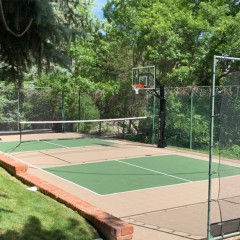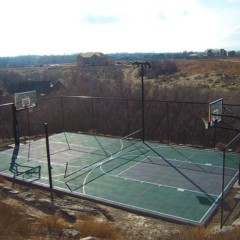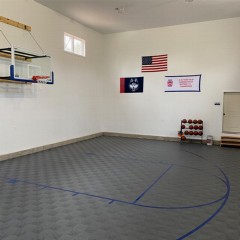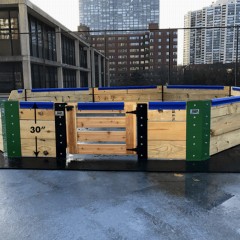Options for Outdoor Court Tiles
When you want the kids to get some exercise – and when you want to be able to join the game – getting them interested in sports like basketball, tennis, or pickleball is a great idea. It’s fun; they gain some confidence as their skills improve … and you can show off your mighty athletic prowess! But joining an athletic club with courts may not be the right solution for your family. Instead, you may prefer to create a space at home, so you can jump into a game whenever you have some free time.
Outdoor sports tiles are a perfect solution for creating a safe and durable space for basketball, tennis, pickleball, and gaga ball at home. Athletic facilities, churches, and schools can also use outdoor athletic court tiles to bring an old, unused space back to life. Trust Greatmats to have interlock floor tiles that will match your needs at a great value, and you’ll be playing your favorite sports in no time.
Best Materials for Outdoor Sports Tiles
Our
modular outdoor game court tiles are available in a few different materials. Match the use case you have in mind with the proper material in the outdoor sports court tiles for sale.
- Polypropylene plastic: Polypropylene plastic is firmer than PVC plastic, making it the best option to install over a hard and flat surface, like concrete. It works especially well for tennis, basketball, roller hockey, and pickleball.
- PVC plastic: When you have a smaller installation in mind, and where you want a softer flooring that’s also flexible, PVC plastic is an alternative especially when you don't need a perfect ball bounce. This can be where small kids are playing and having fun and is not intended for serious play. It's also a great choice for gaga ball pits.
- Rubber: Rubber provides superior traction and is the ideal flooring for gaga ball, which is why we include rubber as the option in all of our premade gaga ball kits. In fact, we have gaga ball kits that fit a specific size of play area, ranging from about 20 by 20 feet to 30 by 30 feet.
Use Cases for Outdoor Court Tiles
If you want the most enjoyable experience with your outdoor sports tiles, it’s important to understand the primary situations where you can use them successfully.
If you need some
sports tiles that will work indoors, too, rather than just outdoors, reach out to the Greatmats customer service team for some advice.
Benefits of Outdoor Sports Tiles
Our outside athletic court tiles are weatherproof and waterproof, making them ideal for use outdoors. They will give you a long-lasting design, even when exposed to the sun for long periods of time, as many of them offer UV protection.
Many of these tiles have perforations that ensure water does not pool on the surface, creating slippery areas.
These materials deliver better traction than concrete or asphalt alone in damp or dry conditions.
You don’t need to hire a pro for the installation, either, as these interlocking tiles pop together with minimal effort. They stay together without needing to use adhesive on the edges.
Outdoor Court Tiles Q&A
What is the best portable pickleball flooring?
The
best portable pickleball flooring involves materials that provide a bit of cushioning, that allow rainwater to drain away, and that last a long time. Select a lightweight tile that you can easily carry with you to set up a game of pickleball anywhere.
What are the best outdoor basketball court surfaces for backyard courts?
The
best outdoor basketball court surfaces offer traction so the players can make safe cuts, while also delivering more cushion than concrete. Durability is important to ensure you receive great value. Having perforations in the tiles allows rainwater to drain.
Can you lay basketball court tiles over grass?
To
create a basketball court in your backyard over grass, you should set up a base layer to provide a sturdy surface for the tiles. Then lay the interlocking tiles over the top.
What are normal pickleball court dimensions and some tips for building a pickleball court?
One of the advantages of playing pickleball versus tennis is that the
pickleball court dimensions are smaller at 44 by 20 feet. When making a court, create space for an out-of-bounds area that also uses the same flooring, so players don’t risk tripping when chasing a ball off the court. You want to create a sturdy base where you can place interlocking tiles over the top, or you can use an existing concrete or asphalt slab.
 $3,06508 /Kit You Save 20%$5.49/sqftShips Out in 3-5 Working Days SustainableShop$5445 /TileShips Out in 3-5 Working DaysShop$1292 /Tile You Save 19%$9.29/sqftShop$500 /Tile You Save 25%$5.00/sqftShips Out in 1-3 Working DaysShop$630 /Tile You Save 25%$6.30/sqftShips Out in 1-3 Working DaysShop
$3,06508 /Kit You Save 20%$5.49/sqftShips Out in 3-5 Working Days SustainableShop$5445 /TileShips Out in 3-5 Working DaysShop$1292 /Tile You Save 19%$9.29/sqftShop$500 /Tile You Save 25%$5.00/sqftShips Out in 1-3 Working DaysShop$630 /Tile You Save 25%$6.30/sqftShips Out in 1-3 Working DaysShop













































































